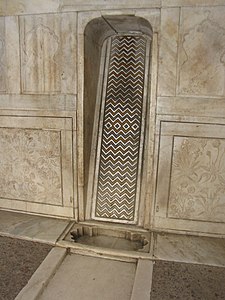Salsabil (fountain)

A salsabil (or salasabil
Etymology and name
The name salsabil likely derives from a Qur'anic reference.[6] The term shadirwan is also used for devices for aerating drinking water.[7][2] However, the term shadirwan or shadirvan has slightly different uses in other cultures, such as designating a central ablutions fountain for a mosque courtyard in Turkish (see shadirvan).[8][9]: 459
Design and setting
The water flows in a manner designed to maximize the surface area, and thus evaporation. A salsabil may be a near-vertical marble waterfall mounted on a wall,[4] or the sheet of water may flow down a slanted chute.[3]
A salsabil may also be used to
Salasabils were used in Mughal architecture from the 1200s to the 1600s. They were also used in recent centuries in Iran.[3] They were sometimes used as decorative features in Ottoman domestic architecture.[12][9]: 441
-
Near-vertical salasabil in the mostly-1500s Agra Fort (dry)
-
1660s Bibi Ka Maqbara, Aurangabad, Maharashtra, India (dry)
-
Replica of a Roman fountain in the House of the Large Fountain, Pompeii.
-
A near-horizontal ridged channel in the Room of Justice, 1360sAlcazar of Seville, Spain (wet)
-
Water flows out over the corrugated sides of a fountain, 1360s Patio del Cuarto Dorado, Alhambra, Granada, Spain (wet)
-
Privy Chamber of Murat III, late 16th century, Topkapı Palace, Istanbul, Turkey (dry)
-
Marble salsabil in theal-Ghuriya Complex, Cairo, Egypt (dry)
See also
References
- ISBN 9781861266095.
- ^ ISBN 9789004161214.
- ^ .
- ^ a b c Amro, Dana K.; Bahauddin, Azizi. Analysis of the architectural elements in traditional courtyard houses in Irbid, Jordan. - Free Online Library.
- ^ "Splendors of Topkapi, Palace of the Ottoman Sultans". Smithsonian Magazine. February 2000. Retrieved 2009-06-02.
- JSTOR 1602278.
- ^ ISBN 9789774160776.
- ^ Sumner-Boyd, Hilary; Freely, John (2010). Strolling Through Istanbul: The Classic Guide to the City (Revised ed.). Tauris Parke Paperbacks.
- ^ ISBN 0500274290.
- ^ Niktash, Amirreza; Huynh, B. Phuoc (July 2–4, 2014). Simulation and Analysis of Ventilation Flow Through a Room Caused by a Two-sided Windcatcher Using a LES Method (PDF). Proceedings of the World Congress on Engineering.
- ^ ISBN 9789774162053.
- ISBN 9781851496044.








